Discover the 12 best REST API documentation tools in 2025. Our in-depth review covers features, pricing, and pros/cons to help you choose the right solution.
An API without clear, comprehensive documentation is like a powerful engine without a user manual: its potential remains locked away. Developers will struggle to integrate it, adoption rates will plummet, and the value of your service will be severely undermined. The difference between a widely adopted API and one that languishes in obscurity often comes down to the quality of its documentation. This is where dedicated REST API documentation tools become critical infrastructure, transforming complex API specifications into accessible, interactive, and developer-friendly resources.
These tools solve a fundamental problem: manually creating and maintaining API documentation is a tedious, error-prone process that rarely keeps pace with development cycles. The right platform automates this workflow, ensuring accuracy and consistency while providing an engaging user experience for your API consumers.
This guide provides a comprehensive analysis of the top REST API documentation tools available today, from enterprise-grade platforms to flexible open-source solutions. We will dissect each option, examining key features, pricing structures, distinct advantages, and potential limitations. This detailed breakdown, complete with screenshots and direct links, is designed to help your engineering team select the optimal tool for your specific project requirements, technical stack, and budget. Whether you’re looking to autogenerate docs from an OpenAPI spec with a tool like DocuWriter.ai or build a complete developer hub, you’ll find the insights needed to make an informed decision.
Best for: AI-Powered, Fully-Automated Documentation Workflows
DocuWriter.ai stands out as a formidable, AI-driven platform that moves beyond static documentation generation to offer a holistic solution for modern development teams. It’s engineered to automate the entire documentation lifecycle, from initial creation to continuous updates, making it an exceptional choice for teams aiming to eliminate the manual toil associated with keeping API docs current. The platform’s core strength lies in its intelligent analysis of codebases to auto-generate not just API documentation but a suite of essential engineering assets.
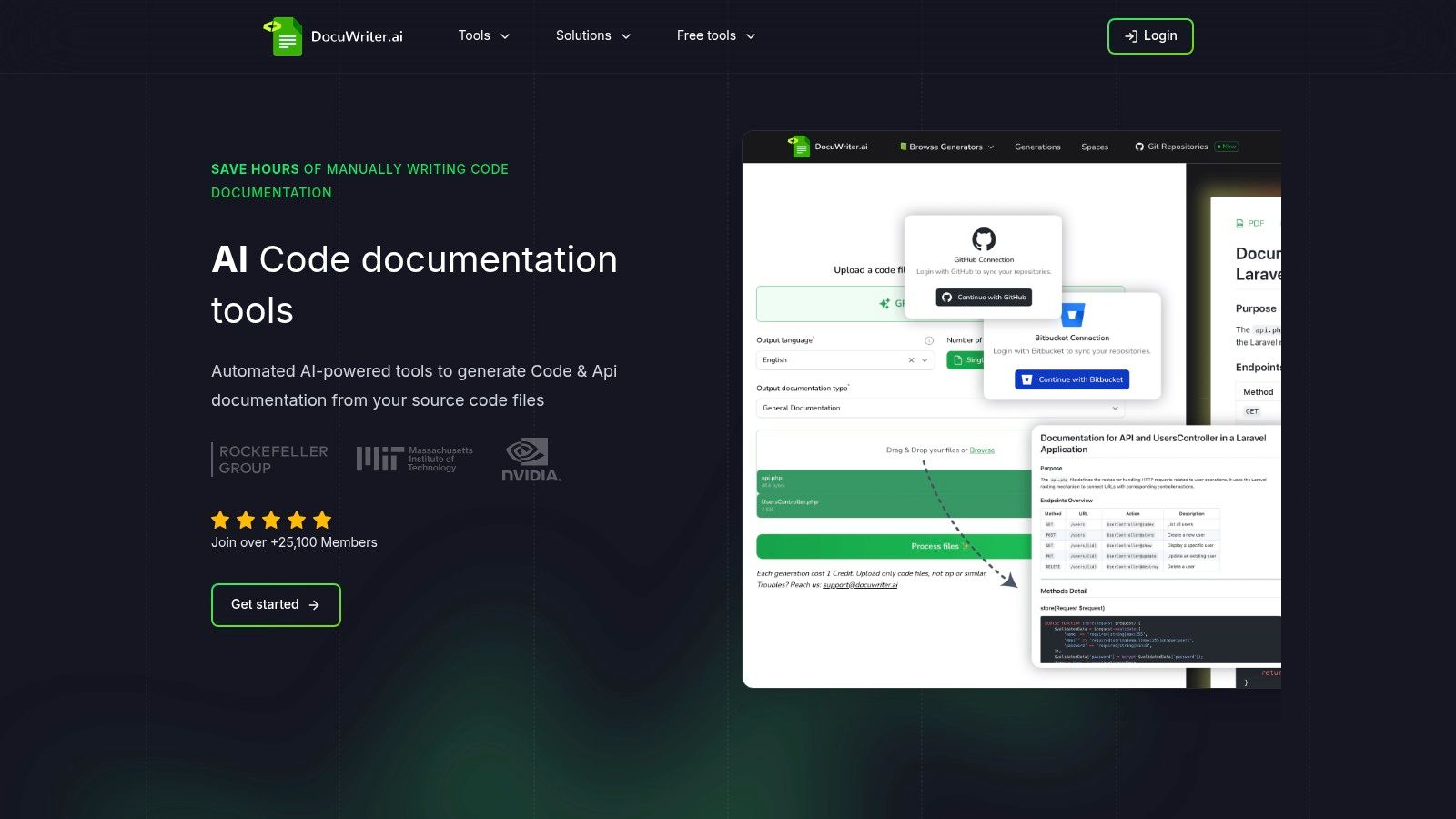
Unlike many REST API documentation tools that focus solely on parsing existing specifications, DocuWriter.ai actively creates them. It can generate Swagger-compliant OpenAPI specifications directly from your codebase, ensuring that your documentation is always an accurate reflection of your API’s endpoints, schemas, and operations. This feature alone drastically reduces the risk of documentation drift. For more in-depth architectural insights, its ability to produce UML diagrams from code provides an invaluable visual aid for complex systems.
DocuWriter.ai’s capabilities extend well beyond basic documentation, positioning it as a comprehensive development accelerator.
Pros:
Cons:
By treating documentation as a continuous, automated process integrated directly into the development workflow, DocuWriter.ai proves itself as one of the most advanced and practical rest api documentation tools available. For a deeper dive into its capabilities, you can learn more about its auto-generation process on DocuWriter.ai.
Ready to automate your documentation? Try DocuWriter.ai for free and see how it can transform your development workflow.
Postman has evolved from a simple API client into a comprehensive API platform where documentation is a core, integrated component of the API lifecycle. It stands out by embedding documentation directly within the development workflow that millions of developers already use for API testing and design. This tight integration makes it one of the most practical rest api documentation tools for teams that prioritize development velocity and a single source of truth.
The platform allows you to automatically generate interactive, machine-readable documentation directly from your Postman Collections or by importing an OpenAPI specification. Developers can try out API endpoints directly from the documentation page, which significantly lowers the barrier to adoption for API consumers. This cohesive experience, from testing to documentation, is Postman’s key differentiator.
Postman operates on a freemium model. The Free tier is quite generous, allowing for collaborative work and public documentation views. For private documentation, advanced governance, and higher usage limits on features like mock servers and monitors, paid plans are necessary. The Basic plan starts at $14/user/month (billed annually), with Professional and Enterprise tiers offering more advanced security and management features.
Best suited for: Development teams already using the Postman ecosystem for API testing and design. Its seamless workflow makes it ideal for agile environments where documentation needs to keep pace with rapid development cycles.
However, its primary limitation is that advanced features are locked behind paywalls. While the free public documentation is excellent, teams requiring private docs or extensive mock server usage will incur costs. Additionally, customization options for the look and feel of the documentation are less extensive compared to dedicated static site generators.
Website: https://www.postman.com/
SwaggerHub by SmartBear is an integrated API design and documentation platform built around the OpenAPI Specification. It excels in providing a collaborative environment where teams can design, build, and document their APIs in a centralized hub. For organizations scaling their API programs, SwaggerHub is one of the most robust rest api documentation tools available, offering strong governance features and a single source of truth for API contracts.
The platform provides hosted, interactive documentation portals that are automatically generated from the OpenAPI definitions. This ensures that consumer-facing documentation is always synchronized with the API’s design. Its key differentiator is its enterprise-grade focus, combining collaborative design with versioning, style validation, and integrations into the wider CI/CD pipeline, making it a cornerstone for API-first development at scale.
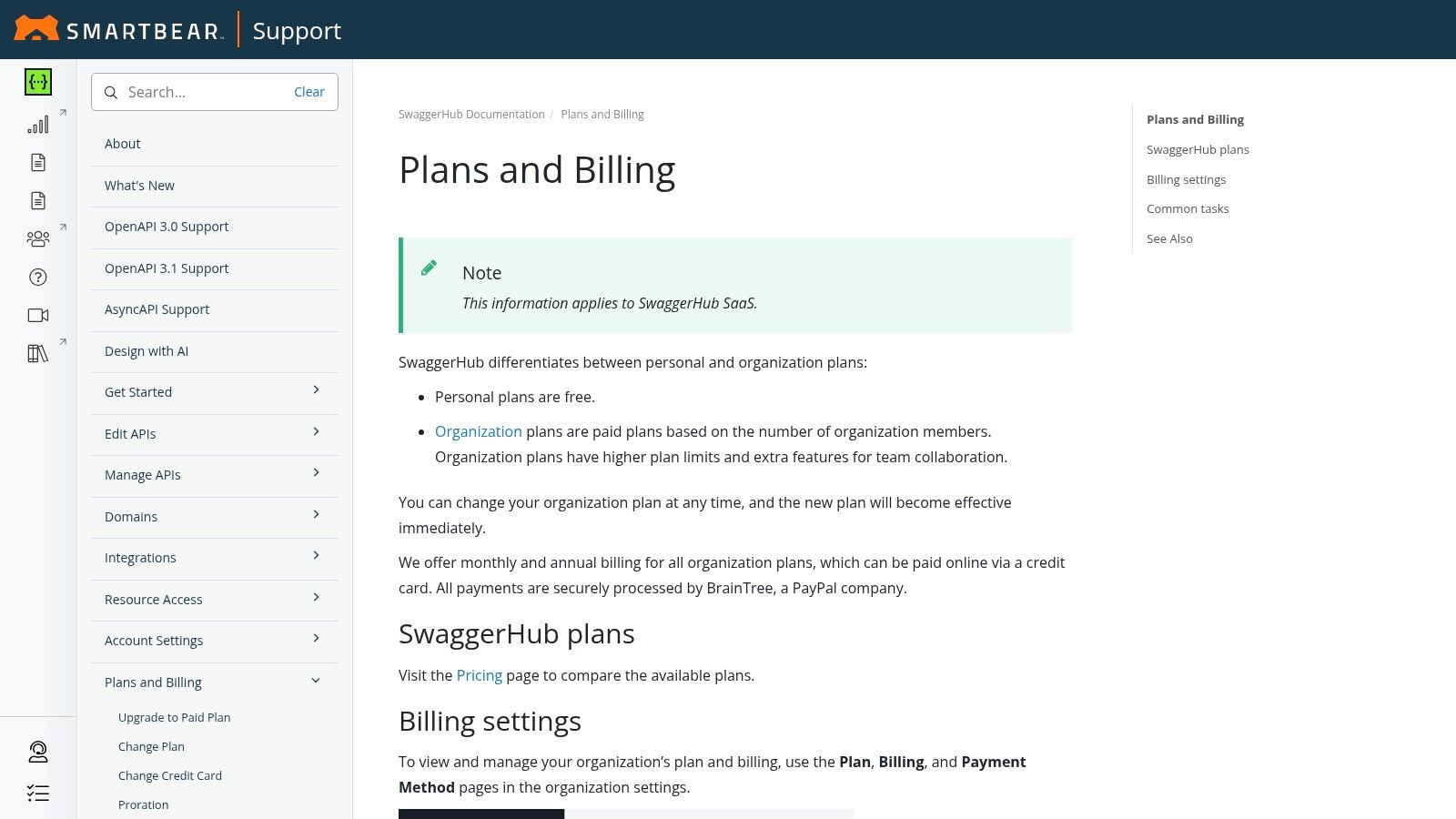
SwaggerHub offers several tiers. A Free plan is available for individuals to design and document up to three APIs publicly. The Team plan starts at $75/month for 5 users (billed annually), introducing private APIs and collaboration features. For enterprise needs like on-premise deployment, advanced governance, and dedicated support, the Enterprise plan is available with custom pricing.
Best suited for: Mid-to-large enterprises and teams that need a centralized, collaborative platform to manage the entire API design lifecycle with strong governance. It’s ideal for organizations standardizing on the OpenAPI Specification.
The primary limitation is its cost for team and enterprise features. While the free tier is useful for personal projects, true collaborative power and private documentation are only available in paid plans. The pricing model, which often requires contacting sales for enterprise features, can be a hurdle for smaller teams looking for transparent, immediate access.
Website: https://support.smartbear.com/swaggerhub/docs/en/plans-and-billing.html?utm_source=openai
Redocly specializes in creating high-performance, elegant, and user-friendly API documentation. It champions the three-panel documentation layout, which has become an industry standard for its clarity and navigability. Unlike tools that bundle documentation as one of many features, Redocly is purpose-built for API docs, focusing intensely on speed, design, and developer experience. This dedication makes it one of the premier rest api documentation tools for organizations that treat their API as a first-class product.
The platform is designed around the OpenAPI Specification, transforming a standard spec file into a beautifully rendered, interactive reference portal. Its modular product suite allows teams to start with simple, open-source documentation and scale up to a full-fledged developer portal with advanced governance, collaboration, and API monitoring capabilities as their needs evolve.
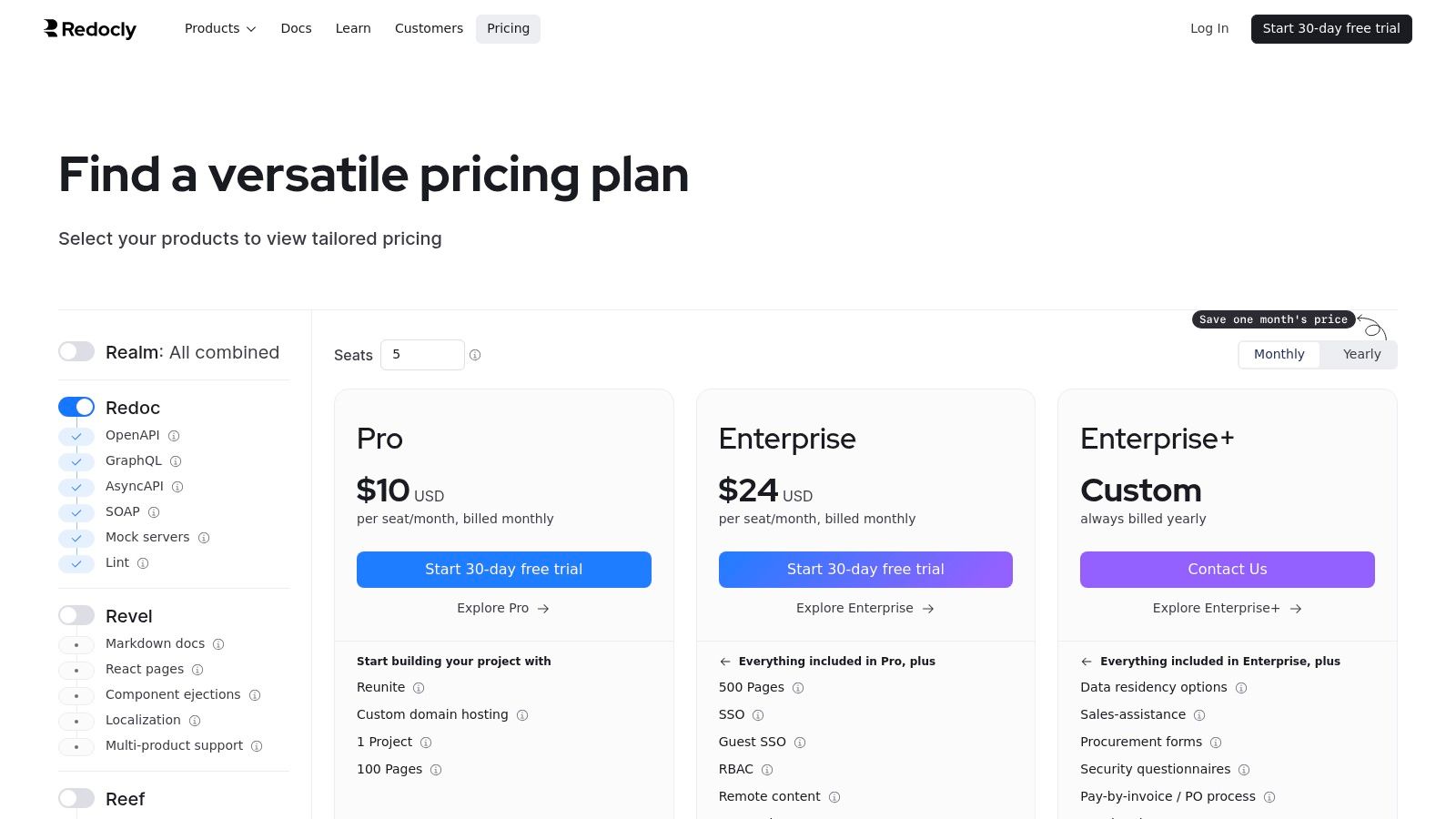
Redoc and later adopt paid products for developer portals (Workflows) and API governance (API registry), allowing for gradual investment.Redocly offers several tiers. The Community edition (Redoc) is open-source and free. The Starter plan is priced at $79/month, offering core developer portal features for smaller teams. The Business plan adds SSO, RBAC, and advanced governance features, while the Enterprise tier provides a custom solution with dedicated support. They also offer a startup discount program, making it accessible for new ventures.
Best suited for: Companies that prioritize a premium developer experience and view their API documentation as a critical product asset. Its scalability makes it ideal for businesses planning to grow from a single API to a comprehensive developer ecosystem.
The primary limitation is its strong focus on the OpenAPI Specification; integrating non-OAS content like guides and tutorials requires using their broader developer portal products. Additionally, while powerful, some advanced features like API monitoring are usage-metered, which can lead to variable costs depending on API traffic and usage patterns.
Website: https://redocly.com/pricing/?utm_source=openai
ReadMe excels at creating comprehensive and engaging developer hubs, moving beyond just API references. It provides a hosted, polished platform where interactive documentation is combined with user guides, changelogs, and community feedback mechanisms. This holistic approach makes it one of the premier rest api documentation tools for companies focused on delivering a world-class developer experience and reducing support overhead through self-service resources.
The platform’s strength lies in its user-friendliness for both developers and non-technical contributors like product managers or technical writers. You can import an OpenAPI specification to instantly generate an interactive API explorer, and then enrich it with detailed tutorials, getting-started guides, and release notes, all within a single, cohesive interface. ReadMe’s focus on the complete developer journey, from first contact to ongoing engagement, is its core differentiator.
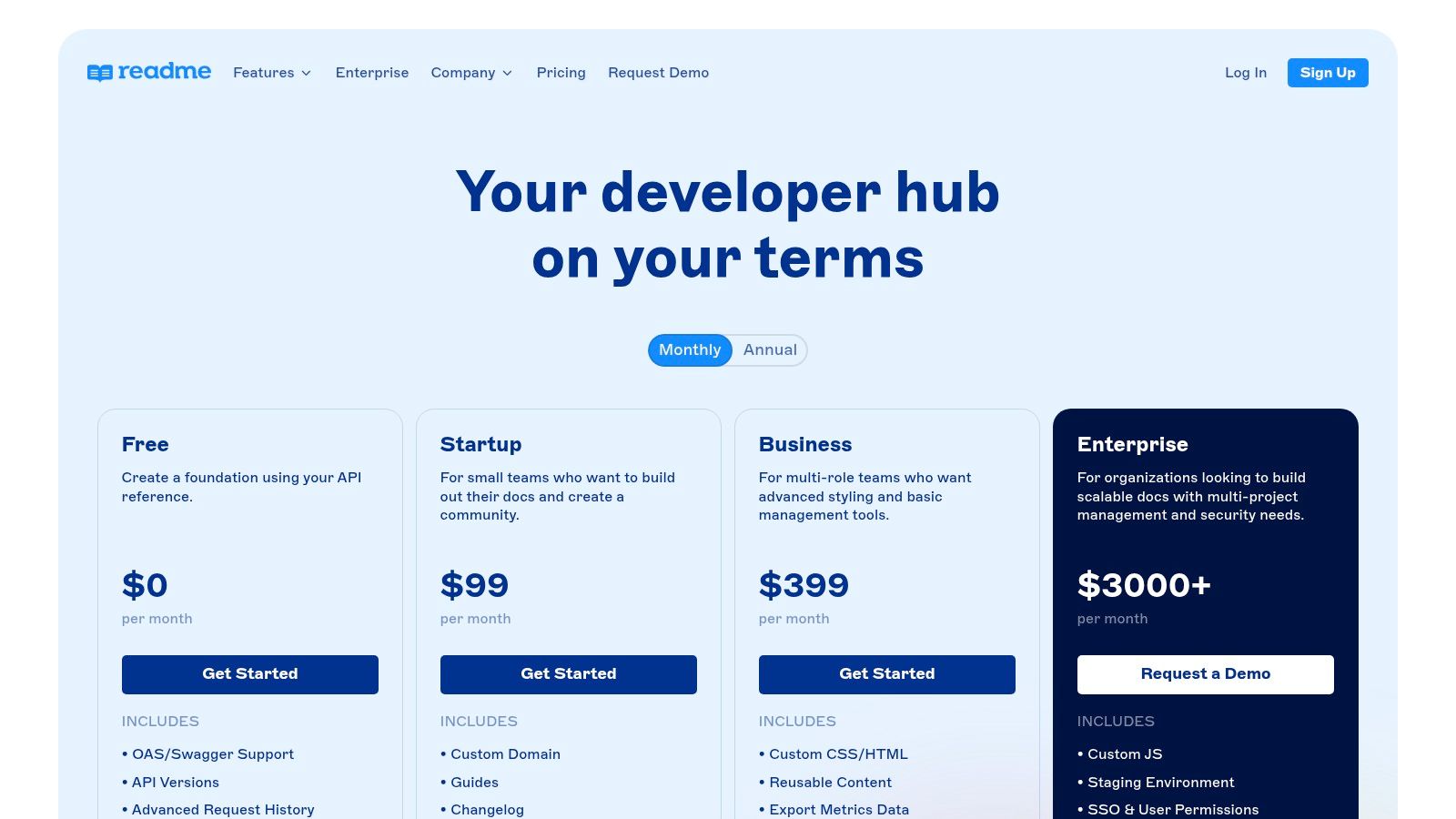
ReadMe’s pricing starts with a Free plan for open-source projects, which includes the core documentation features. The Startup plan begins at $99/month per project and is aimed at small teams needing a custom domain and basic features. The Business and Enterprise tiers offer advanced features like API metrics, user-level permissions, and premium support, with pricing available upon request.
Best suited for: Businesses that want to provide a polished, all-in-one developer portal without building it from scratch. It is ideal for teams where non-technical members need to contribute to documentation easily.
The primary limitation is cost, as key features like API metrics and the AI assistant (Owlbot) are paid add-ons that can significantly increase the total price. Additionally, it is less focused on the API design and governance aspects of the lifecycle compared to integrated suites like Postman or Stoplight.
Website: https://readme.com/pricing/?utm_source=openai
Stoplight champions a design-first approach to the API lifecycle, positioning itself as a comprehensive platform where documentation is a natural output of a well-defined design and governance process. It excels at creating a collaborative environment for designing, mocking, and documenting APIs, making it a powerful choice among rest api documentation tools for teams that prioritize consistency and quality control from the very beginning. The platform is built around the OpenAPI specification, providing a visual editor that simplifies the creation and management of complex API definitions.
What sets Stoplight apart is its emphasis on API governance. Using its open-source linter, Spectral, teams can enforce style guides and best practices directly within the design phase. This ensures that all APIs, and their resulting documentation, adhere to organizational standards, creating a consistent and predictable developer experience for API consumers.
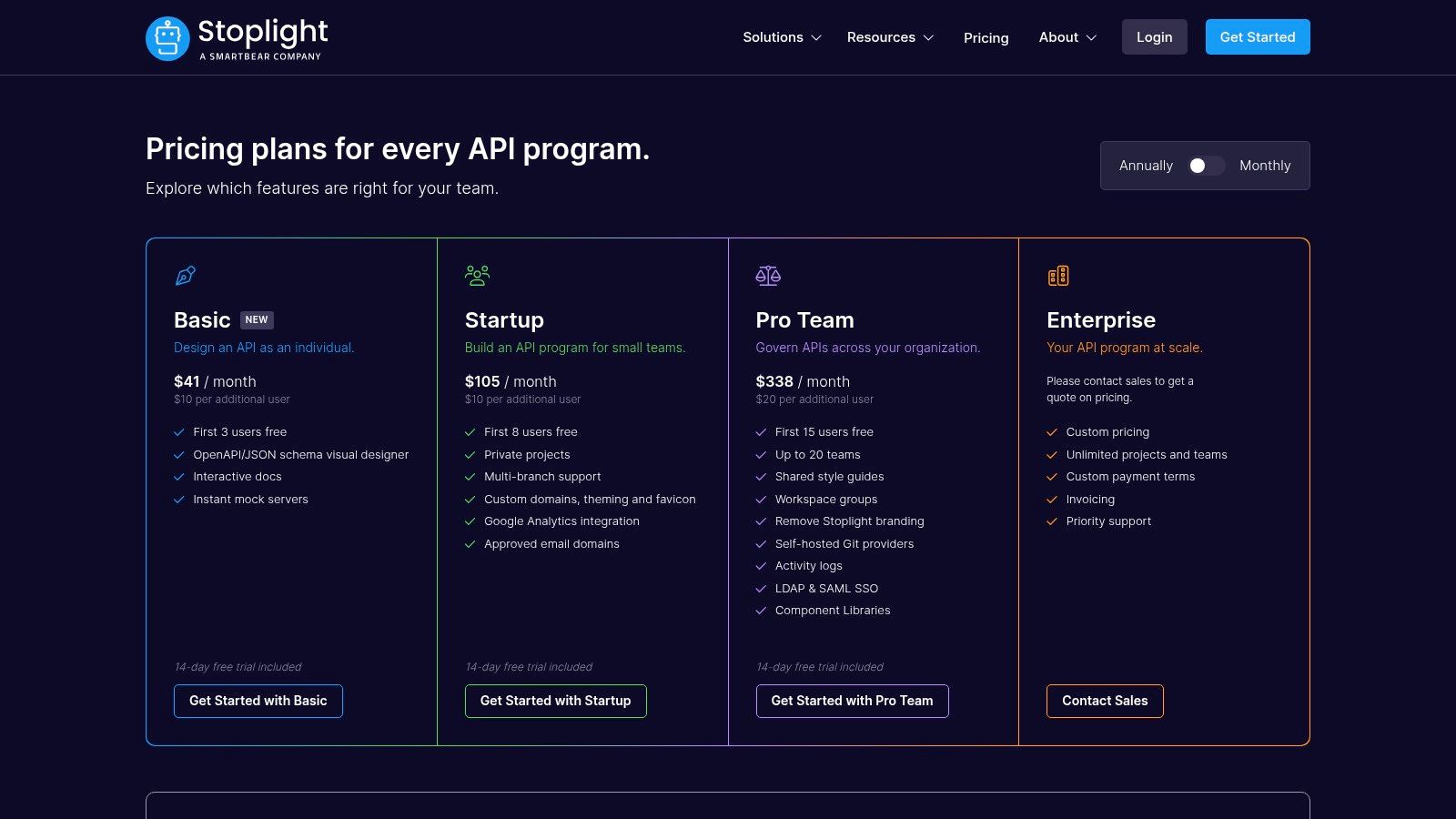
Stoplight offers several tiers. A Free plan is available for individuals and small projects, providing basic features. The Starter plan, at $99/month, adds custom domains and more robust features for growing teams. The Professional and Enterprise plans offer advanced governance, Git integrations, and enterprise-grade security for larger organizations with more complex needs.
Best suited for: Organizations committed to a design-first API strategy that requires strong governance and collaboration tools. Its visual editor and integrated style guides make it perfect for teams aiming to standardize their API portfolio.
A potential consideration is that its product roadmap is now influenced by its acquisition by SmartBear, which could alter its future direction. Additionally, many of its most powerful features, particularly around advanced governance and Git workflows, are reserved for the higher-priced tiers, making it a significant investment for smaller teams.